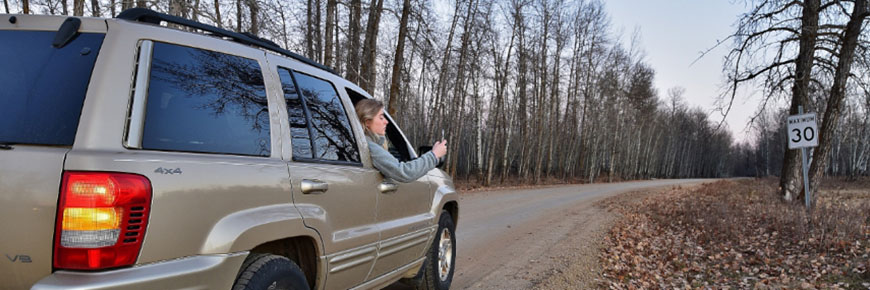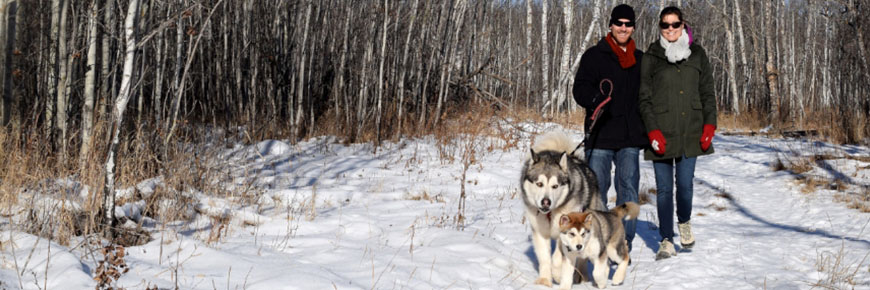
Safety on land
Elk Island National Park
Exploring the scenic isolation of a national park can be invigorating, and it can also be challenging. Prepare for each park adventure by taking the essential items, filing a trip plan with a trusted adult, being familiar with equipment and planning for varied weather conditions.
No matter what activity is planned, remember to purchase a park entry pass. Entry and service fees support services and facilities visitors enjoy. Park passes are available in-person at Parks Canada's entry gates, information centres, and online.
Camping
Safety is a shared responsibility. Practice safe camping and picnicking practices, obey camping and other national park regulations including keeping pets on a leash, and keeping food and garbage secure at all times. Ensure a safe camping experience by following these rules:
Keep campsites clean at all times
Store all food, garbage and scented items in a vehicle or a bear proof storage container when not in use.
Do not cook in or near a tent. Lingering odours may attract wildlife.
Scented items should be stored in a secure location such as a vehicle when camping in the Astotin Lake Campground or the designated bear proof food storage lockers when camping at the Oster Lake Backcountry Campground when not in use.
Campfire safety
Keep fires within designated fire pits and check local fire conditions before heading out.
Never leave a campfire unattended and be sure to fully extinguish campfires before leaving camp or going to bed at night. Soak the ashes, stir them, and soak them again until ashes are cool to the touch.
Backcountry camping considerations
Potable water is not available at Oster Lake Backcountry Campground. Visitors must bring their own water for drinking and washing.
Access is hike-in only. Be prepared and be self-reliant as cellular telephone coverage varies and may not be available in all areas of Elk Island National Park.
Be aware of bison. Bison are free roaming and frequently visit this area of the park. Learn more about being bison wise.
File a trip plan with a trusted adult and pack the essential items.
Learn more about camping safety, regulations and etiquette specific to Oster Lake Backcountry Campground.
Driving
Spotting a herd of bison along the parkway is a classic Elk Island National Park experience. Follow these tips to have a safe and enjoyable adventure on the road:
Plan ahead
Check the Elk Island National Park forecast and road conditions using Alberta 511 before departure.
Come prepared with a full tank of fuel and emergency supplies needed. There are no gas stations in Elk Island National Park.
Obey posted speed limits
Obey posted speed limits: 60 km/hr max on the main Elk Island National Park Parkway, 40 km/hr max on secondary roads, and 20 km/hr max in the Astotin Lake Recreation Area.
Slow down and be aware of surroundings.
View wildlife safely
When driving by wildlife stay in the vehicle. Watch for a few moments, take a quick photo, and move on to allow other visitors to enjoy the park.
Pull over at designated viewing areas. Use hazard lights to alert other drivers to slow down.
Do not approach or entice wildlife. Keep wildlife wild. It is illegal to feed, entice or disturb any wildlife in a national park.
Report injured (open wounds) or deceased wildlife along the roadway to Parks Canada Dispatch 1-877-852-3100 as soon as possible. Let staff know the exact location of the animal, type and colour, if it has young, and if it has identifiers such as a collar or ear tags.
Stay alert
Watch out for wildlife. Wildlife that become comfortable around people and places, like roadsides, are at greater risk of being struck by vehicles. Bison are especially difficult to spot at night and often linger on roadways.
Be aware of wildlife on roadways especially at dawn and dusk when animals are most active and low light can make them difficult to see. Large animals such as bison and elk with dark brown colouring can blend into the landscape in low light.
Pay special attention when driving at night as wildlife are often challenging to see, even with headlights on.
Watch for cyclists, joggers and roller skiers. They may be difficult to see, especially at dawn and dusk.
Slowdown in bad weather or stop somewhere safe and wait it out.
Hiking
Elk Island National Park offers 11 hiking trails of varying lengths and difficulties. Whether enjoying a short stroll or exploring on a full day hike, prepare for the unexpected. When preparing to hike, check the weather forecast, the park’s trail condition report, pack the essentials and file a trip plan with a trusted adult. Ensure a safe visit by following these tips:
Stay on the trail
Remain on the trail as it is easy to get lost among the hidden areas of quicksand and boggy areas throughout the park. Staying on the trail also allows better access for search and rescue if needed.
Stay alert
Do not hike, bike, recreate, and cycle with ear buds. Listening to music with ear buds eliminates one of the five senses needed to stay safe in nature.
Make noise to alert animals someone is nearby on trails. When hiking with a friend or in a group, alert animals by making noise. A surprised animal might react aggressively to defend itself, or to protect a young one or a food source.
Be bison wise. Do not approach a bison closer than 100 metres and never try to chase or scare bison away.
Rule of Thumb – what does 100 metres look like?
Hold your fist straight out in front of you and raise your thumb. Cover the bison (who is standing sideways) with your thumb. If the bison is totally covered you are about 100 metres away, a safe distance. If not, retreat slowly. If your thumb does not cover the bison, retreat slowly.
Take only photos
Enjoy the trails! Leave all rocks, fossils, horns, antlers, wildflowers, nests and other natural or historic objects where they are for others to enjoy. It is unlawful to remove, deface, damage or destroy any natural or cultural resources within Canada’s national parks.
Share the trail
Trails are shared by hikers, trail runners, mountain bikers, horseback riders and wildlife alike. Respect other users and yield the right of way to ensure safety.
Use extra caution when cycling. Cyclists can quickly and quietly startle wildlife.
Ensure pets are on a leash and under control at all times.
Pets cause stress for wildlife. Dogs, like wolves and coyotes, may be seen as a threat.
For the safety of pets and wildlife, keep your pet on a leash and under control at all times.
Properly dispose of human waste
Use the outhouses provided. If there are no outhouses nearby, select a spot away from trails, campsites and at least 70 m away from water sources. Dig a hole 12 to 16 cm deep to reach the dark-coloured biologically active soil layer. When filling the hole with soil, do not pack it down.
Diapers are not biodegradable. Pack out all diapers and dispose in the garbage bins provided at each trail head.
Pack out garbage
Pack it in - pack it out. Pack out all garbage and dispose of it in the garbage bins provided at each trail head. Do not dispose of garbage in outhouses. Littering is unlawful and hazardous to wildlife.
More safety tips:
Emergencies:
- Call Parks Canada Dispatch 1-877-852-3100 for incidents involving wildlife, campground disturbances, wildfire, poaching or search & rescue. Response times may vary.
- In case of an emergency, call 911
- Hospitals are located in Lamont and Fort Saskatchewan
It is illegal to feed, entice or disturb any wildlife in a national park. Violators may be charged, be required to appear in court, and could pay fines up to $25 000. To report offenses call Parks Canada Dispatch: 1-877-852-3100.
- Date modified :


